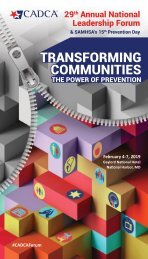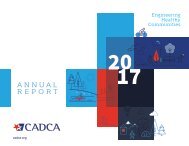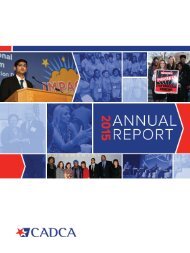GADC-Magazine-Full
Create successful ePaper yourself
Turn your PDF publications into a flip-book with our unique Google optimized e-Paper software.
“That dialogue didn’t exist prior to<br />
1988,” recounted Bill Laubernds, who<br />
at the time was working on the reuse of<br />
Kincheloe Air Force Base in the Upper<br />
Peninsula of Michigan. “He got DoD to<br />
understand the need for a program to<br />
assist communities,” Laubernds said.<br />
After leaving OEA, John accelerated his<br />
efforts to organize NAID members, with<br />
the aim of helping closure communities<br />
better understand the base reuse<br />
process and pushing changes to ease<br />
communities’ recovery from closures.<br />
Lynch established an agenda for NAID<br />
to accomplish those goals, something<br />
that the organization didn’t have prior<br />
to that time.<br />
He understood that improving the<br />
base closure process to benefit affected<br />
communities would require working<br />
with the Pentagon to revise its process<br />
for carrying out base closures and<br />
lobbying Congress to update the BRAC<br />
statute. That prompted a “seismic shift<br />
in the organization,” Laubernds said.<br />
Many members of NAID’s board were<br />
not convinced the association should<br />
be taking on that role.<br />
“A lot of people just didn’t view the<br />
organization as supposed to be more<br />
proactive,” Laubernds said. “He changed<br />
the direction of NAID.”<br />
In advocating for defense communities,<br />
Lynch made certain that NAID<br />
did not take a stand on whether<br />
subsequent BRAC rounds were<br />
justified, noted Houlemard.<br />
Instead, he focused on adopting<br />
positions that would strengthen<br />
communities.<br />
“He kept us out of being attacked,”<br />
Houlemard said. Lynch strived<br />
to maintain NAID’s focus on its core<br />
mission of ensuring communities would<br />
not unduly bear the brunt of DoD<br />
actions, he said.<br />
One of the most important changes to<br />
DoD’s BRAC implementation process<br />
Lynch helped spur in the 1990s was the<br />
requirement for the federal government<br />
to consider a community’s reuse plan<br />
when disposing of a closed installation,<br />
Laubernds said.<br />
“He understood that Washington<br />
couldn’t tell a community what to do;<br />
it had to be the local community that<br />
supported the plan,” he said.<br />
Another policy he fought for was the<br />
creation of the economic development<br />
conveyance, allowing communities<br />
to obtain former base property at<br />
below market cost for the purpose of<br />
generating jobs.<br />
“We were able to accomplish quite a bit.<br />
… There were a lot of improvements,”<br />
Laubernds said.<br />
“I view him [John] as the key guy that<br />
took NAID from an organization with<br />
limited [capabilities] to an organization<br />
that could really make a<br />
difference and influence<br />
the process,” he<br />
said.<br />
To fully appreciate how far ADC<br />
has come since its formative years,<br />
Schlossberg said, “[You need to<br />
remember] how fragile things were<br />
with the organization. To get a meeting<br />
in the Pentagon was not an easy thing<br />
because no one had heard of NAID,” he<br />
said.<br />
NAID HELPS<br />
COMMUNITIES<br />
THROUGH BRAC’S EARLY<br />
ROUNDS<br />
Beyond the dialogue NAID forged with<br />
DoD and Congress, the association also<br />
helped communities navigate the BRAC<br />
process in the 1990s when DoD held<br />
three BRAC rounds.<br />
“John envisioned NAID as a resource for<br />
communities to deal with multi-faceted<br />
problems they had no experience<br />
in,” said Paul McCarthy, who was the<br />
Glenview, Ill., village manager when<br />
the BRAC Commission voted to shutter<br />
Naval Air Station Glenview.<br />
The association allowed community<br />
leaders from across the nation facing<br />
similar challenges to learn from each<br />
other. “John saw a need … and NAID<br />
grew as a<br />
America’s Defense Communities | 67











